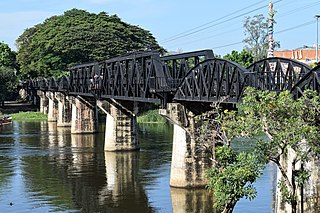
The Burma Railway, also known as the Siam–Burma Railway, Thai–Burma Railway and similar names, or as the Death Railway, is a 415 km (258 mi) railway between Ban Pong, Thailand, and Thanbyuzayat, Burma. It was built from 1940 to 1943 by Southeast Asian civilians abducted and forced to work by the Japanese and a smaller group of captured Allied soldiers, to supply troops and weapons in the Burma campaign of World War II. It completed the rail link between Bangkok, Thailand, and Rangoon, Burma. The name used by the Japanese Government was Tai–Men Rensetsu Tetsudō (泰緬連接鉄道), which means Thailand-Burma-Link-Railway.

Changi Prison Complex, often known simply as Changi Prison, is a prison complex in the namesake district of Changi in the eastern part of Singapore. It is the oldest and largest prison in the country, covering an area of about 50 ha. Opened in 1936, the prison has a rich history.

The fall of Singapore, also known as the Battle of Singapore, took place in the South–East Asian theatre of the Pacific War. The Japanese Empire captured the British stronghold of Singapore, with fighting lasting from 8 to 15 February 1942. Singapore was the foremost British military base and economic port in South–East Asia and had been of great importance to British interwar defence strategy. The capture of Singapore resulted in the largest British surrender in its history.

Bukit Batok, often abbreviated as Bt Batok, is a planning area and matured residential town located along the eastern boundary of the West Region of Singapore. Bukit Batok statistically ranks in as the 25th largest, the 12th most populous and the 11th most densely populated planning area in Singapore. It is bordered by six other planning areas - Choa Chu Kang to the north, northeast and northwest, Cashew to the northeast and east, Clementi to the south, Bukit Timah to the southeast, Jurong East to the southwest and Tengah to the west.

The Pudu Prison, also known as Pudu Jail, was a prison in Kuala Lumpur, Malaysia. Built in phases by the British colonial government between 1891 and 1895, it stood on Jalan Shaw. The construction began with its 394-metre prison wall at a cost of 16,000 Straits dollars, and had been adorned with the world's longest mural at one point in its history.
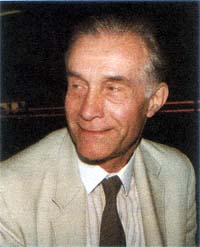
Stanley Warren was an English painter. He was a bombardier of the 15th Regiment of the Royal Regiment of Artillery who became known for the Changi Murals he painted at a chapel during his internment in Changi prison in Singapore during World War II.
Dalforce, officially the Singapore Overseas Chinese Anti-Japanese Volunteer Army was an irregular forces/guerrilla unit within the British Straits Settlements Volunteer Force during World War II. Its members were recruited among the ethnic Chinese people of Singapore. It was created on 25 December 1941 by Lieutenant Colonel John Dalley of the Federated Malay States Police Force. The unit was known to the British colonial administration as Dalforce, after its chief instructor and commanding officer, John Dalley, whereas the Chinese in Singapore only knew it as the Singapore Overseas Chinese Anti-Japanese Volunteer Army. This formation took part in the Battle of Singapore and some members conducted a guerrilla campaign against Japanese forces during the Japanese occupation. The British noted how ferociously the Chinese volunteers in Dalforce fought, earning them the nickname Dalley's Desperadoes.

The Selarang Barracks incident, also known as the Barrack Square incident or the Selarang Square Squeeze, was a revolt of British and Australian prisoners-of-war (POWs) interned in a Japanese camp in Changi, Singapore.

The Bukit Batok Memorial is located on top of the tranquil Bukit Batok Hill upon which once stood two war memorials built by Australian POWs to commemorate the war dead of the Japanese and the Allies who fought during the decisive Battle of Bukit Timah in Singapore during the Second World War. The two memorials were destroyed after the war and only the road and stairs that used to lead to them mark its legacy today.

The Japanese Cemetery Park is a Japanese cemetery and park in Hougang, Singapore. It is the largest Japanese cemetery in Southeast Asia at 29,359 square metres, consisting of 910 tombstones that contain the remains of members of the Japanese community in Singapore, including young Japanese prostitutes, civilians, soldiers and convicted war criminals executed in Changi Prison. It was gazetted as a memorial park by the Singapore government in 1987.
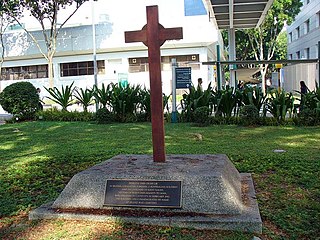
The SGH War Memorial is located within the grounds of the Singapore General Hospital (SGH) in Outram. This memorial marked the tragedy and the burial site of a group of medical students from the King Edward VII College of Medicine, who were killed during the Second World War in Singapore. In 2005, the memorial, along with eight other historic sites of SGH, was incorporated as part of the Outram Campus Heritage Trail that allow visitors to explore the important historical landmarks that are closely linked with the history of medical education in Singapore.

The Battle of Kranji was the second stage of the Empire of Japan's plan for the invasion of Singapore during the Second World War. On 9 February 1942 the Imperial Japanese Army assaulted the north-western front of Singapore, capital of the Straits Settlements.

Lionel Colin Matthews, was an Australian Army officer in World War II. He was posthumously awarded the George Cross, the highest award for extraordinary acts of gallantry away from the field of battle that could be awarded to a member of the Australian armed forces at the time. Matthews was born in Adelaide, South Australia, and was schooled there before moving to Victoria. He trained as a signalman in the Royal Australian Naval Reserve before joining the Militia in April 1939. Commissioned as an officer in the Australian Corps of Signals, Matthews transferred to the 8th Division of the Second Australian Imperial Force after the outbreak of World War II.
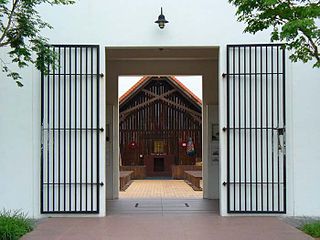
The Changi Chapel and Museum is a war museum dedicated to Singapore's history during the Second World War and the Japanese occupation of Singapore. After the British Army was defeated by the Imperial Japanese Army in the Battle of Singapore, thousands of prisoners of war (POWs) were imprisoned in Changi prison camp for three and a half years. While interned there, the POWs built numerous chapels, one of which was named St George's Church.

The Changi Air Base is a military airbase of the Republic of Singapore Air Force (RSAF) located at Changi, in the eastern tip of Singapore. Sited at two locations to the east and west of Singapore Changi Airport, the base co-shares runway facilities with the civilian airport and currently occupies a third runway slated for future expansion for civilian use by Singapore Changi Airport. Together, the two airfields house 121 Squadron, 112 Squadron, 145 Squadron, the Field Defence Squadron, the Air Logistics Squadron and the Airfield Maintenance Squadron. The air base badge carries the motto Together in Excellence.
Changi is the area in eastern Singapore.
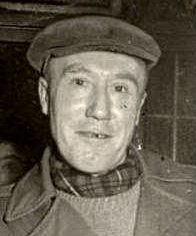
Ashley George Old was an artist best known for documenting the lives of prisoners of war forced to construct the Thailand-Burma Railway.
John George Mennie, A.R.M.S. D.A.(ABDN). ARMS., was a Scottish artist who came to public attention in 2011 for his many contemporaneous drawings of his life as a prisoner of war during the Japanese occupation of Singapore and Thailand in World War II. The drawings were made in secret depicting scenes of daily life and personalities in the camps in Singapore and Thailand, working on the Death railway. They also uniquely documented the Selarang Square Squeeze when some 17,000 prisoners were forced to crowd in the barracks square for nearly five days with little water and no sanitation until they signed a 'promise not to escape'.
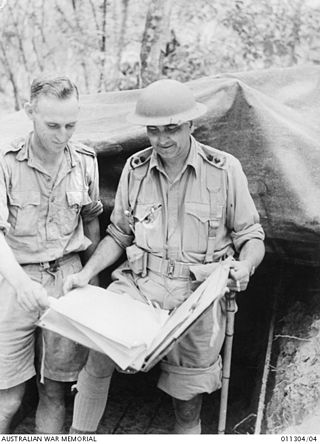
Major General Sir Frederick Gallagher Galleghan, was a senior officer in the Australian Army who served in the First and Second World Wars.
AGH Rostrum Club Changi was a Rostrum Club formed during World War II at the Prisoner of War camp at Singapore's Changi Prison. The club was formed by members of the Australian Army's 13th Australian General Hospital (AGH), 8th Division AIF and probably included other allied servicemen.


















